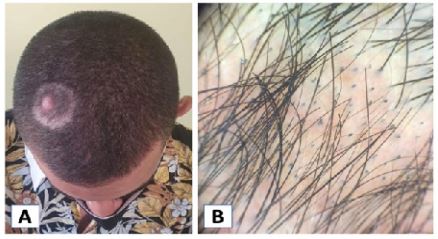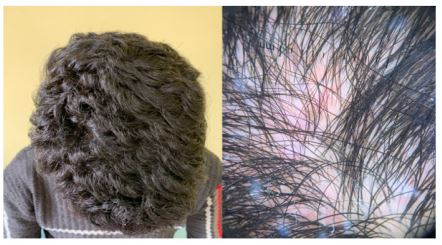Clinical Image - Volume 2 - Issue 6
Annular alopecia unlike any other
Hashasi FZ*; Bay Bay H; Chhiti S; Douhi Z; Elloud S; Mernissi FZ
Department of Dermatology and Venereology, University Hospital Hassan II, Route Sidi Hrazem, Faculty of Medicine and Pharmacy,Sidi Mohamed Ben Abdellah University, Fez, Morocco.
Received Date : Oct 11, 2022
Accepted Date : Nov 19, 2022
Published Date: Dec 13, 2022
Copyright:© Hashas fatima zahra 2022
*Corresponding Author : Hashas fatima zahra, Department of Dermatology and Venereology, University Hospital Hassan II, Route Sidi Hrazem,Faculty of Medicine and Pharmacy, Sidi Mohamed Ben Abdellah University, Fez, Morocco.
Email: hashas.fz@gmail.com
DOI: Doi.org/10.55920/2771-019X/1320
Key words: Trichotillomanie; alopecia, trichilemmal cyst.
Clinical Image
A 23 year old patient, with no medical history presented with an asymptomatic lesion on scalp that had been evolving for 3 years. Clinical examination showed asmooth, mobile, firm, and well-circumscribed nodulesurrounded by a Well-defined annular patcheof non scarring alopecia (Figure 1), hair pull test was negatif. On trichoscopy we found irregularly broken hairs, black dots and flaming hairs, the rest of the scalp and body hair were without abnormalities. Based on the typical clinical presentation, the diagnosis of trichotillomania associated to trichilemmal cyst was made and the patient was treated with surgical removal of the the cyst. There was a normal hair regrowth in the scalp after cognitive -behavioral management (Figure 2).
Trichotillomaniais a self-induced hair loss originating from pulling of one’down hair repetitively in a compulsive manner, leading to significant hair loss. The diagnosis my be diffect when patients deny that they are pulling the hair out [1]. Dermoscopy is very useful because it reveals specific diagnostic feauture as: different levels of broken hair, Tulip hairs, flame hairs, V hairs, trichoptilosis and coiled hairs. Traitement options include cognitive behavioral therapy, pharmacological management, and combination therapies. Trichotillomania is a chronic condition of varying severity, hence the need for early and effective diagnosis and treatment.

Figure 1: Clinical and dermoscopic features of trichotillomania. (A)Well-defined annular patche of non scarring alopecia, (B)irregularly broken hairs, black dots and flaming hairs.

Figure 2: Good improvement after treatment.
References
- Elmas ÖF, Metin MS. Trichoscopic findings of trichotillomania: new observations. Postepy Dermatol Alergol. 2020; 37(3): 340-345. [PMID: 32792873; PMCID: PMC7394151 DOI: 10.5114/ada.2020.96295].
- Farhat LC, Olfson E, Nasir M, Levine JLS, Li F, Miguel EC, Bloch MH. Pharmacological and behavioral treatment for trichotillomania: An updated systematic review with meta-analysis. Depress Anxiety. 2020; 37(8): 715-727. [PMID: 32390221 DOI: 10.1002/da.23028]

